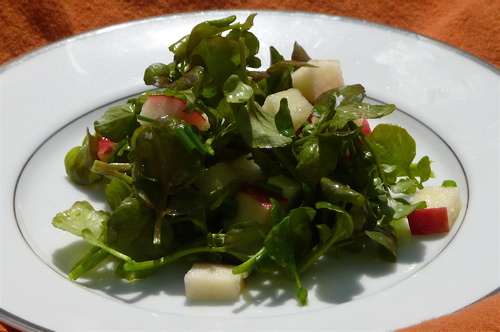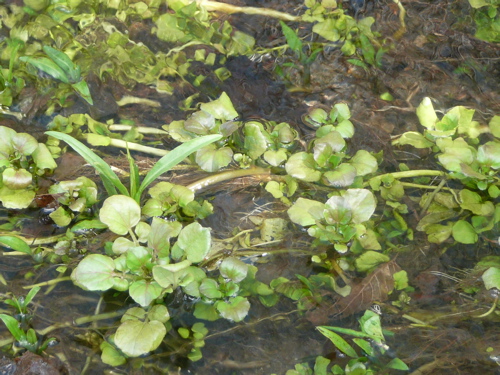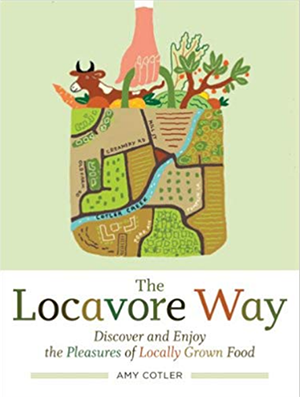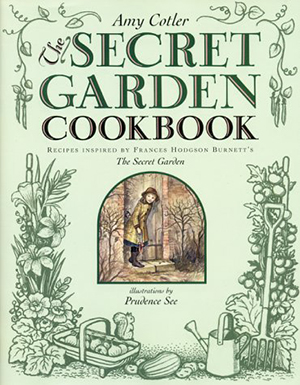 Toss the first of spring watercress with the fall of the apples.
Toss the first of spring watercress with the fall of the apples.
I lived in my 1810 house for 20 years before I had the sense to look down at the spring behind it and recognize fresh watercress. There it was, looking just like the store-bought stuff, but younger and fresher.
If you live near very fresh running water, likely you’ll find it too. Harvesting requires leak proof boots, a long reach, or the willingness to get muddy. If you can’t find it, use the first of the spring greens.
I tossed the cress with the first of the garden’s chives and the last of the storage apples, Northern Spy, an heirloom variety from Bartlett’s Orchard, which still has some character and crunch left. The resulting combo needs no recipe really, but tastes of spring.
For each serving:
A handful of wild watercress or other spring herbs
1/4 of a big apple, skin on, diced
1-2 generous pinches of chopped chives
1 pinch kosher or sea salt
Olive oil
Vinegar, cider, white or red wine
1-Wash the watercress well in cold water, picking out any weeds or roots clinging to it. Spin dry. Toss with the chives and apple to combine.
2-Toss once with a pinch of salt and just enough olive oil to coat. Then toss a second time with just a tiny drizzle of vinegar to taste. Serve immediately.
***
Photos of the Oaxacan market: Just reinserted the memory card into my camera and there were the market pictures from my recent trip to Oaxaca. Click the link here, then check them all out, from fried grasshoppers to chilies galore. Below is the wild watercress in my backyard.
When buying the apples used in this recipe or when shopping for any food at all, how do you decide which is better: Local or organic?
From the perspective of this locavore: Local organic and local sustainably produced foods are best. Understanding the meaning behind this answer will help you make good decisions when you shop.
Let’s start with organic, which may or may not be local. Food labeled organic is required to be grown, raised, or produced using federally mandated rules. These standards outline allowable and forbidden materials and practices, which makes good sense. But they don’t stress the integrated nature of farming, including the biological cycles necessary to healthy farming over the long haul. The organic label is also supported by strong agribusiness lobbies, which push for regulations to make their life easy (and our food not quite as safe).
Simultaneously, many of our local farmers are using safe, sustainable methods, which are the equivalent of or even better than established organic methods. (Their farms also boost our local economies and preserve our working landscape.)
They may or may not decide to become certified organic. If they opt out, it may be because their clients know and trust them, making certification unnecessary. Or perhaps they don’t approve of its bias toward big agribusiness; they can’t afford to follow the rules, which don’t encourage small farms; they use another accredited system, such as Certified Naturally Grown (see below); or they prefer to use their own, ecofriendly methods.
So again, that makes local organic and local sustainably raised both the best choices when you shopping. And, of course, knowing and trusting your farmer means you can ask questions about how they raise your food.
Digging Deeper — Naturally Grown? Two Meanings The term naturally grown is used two ways and so needs some clarification for the smart shopper looking to decipher labels. As mentioned above, it is an alternative certification to organic used by many environmentally conscious growers who have decided not to go for organic certification.
Indian Line farmer Elizabeth Keen,who uses the Naturally Grown certification says, Our certification process requires an application, a declaration of intent, a small fee, an inspection and the possibility of random tissue testing of produce. We are required to follow the written USDA standards but aren’t required to do the amount of paperwork involved and the fees are less…. We value our certification as it is an outside perspective on our growing methods that can make the consumer feel confident in how we grow our produce.
That is clear enough, but naturally grown is often bandied about more casually, such as in the You Tube talk about organic coffee that I attached to one of the last posts. There and elsewhere it is frequently used more generally to refer to crops that are grown using eco-friendly methods. Like the word “gourmet” it is vague and in no way a legal term, but is only as trustworthy a term as its source.







